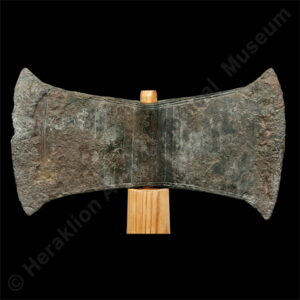
The double axe is a tool with curved cutting edges, usually made of bronze, with a wooden haft. It was an important symbol in Minoan religion and ritual practice, perhaps due to its use in ceremonies involving bull sacrifice, as evidenced by pictorial scenes, the most striking being that on the Agia Triada Sarcophagus. According to ancient sources, the Carian name for the double axe was “labrys”, connecting the symbol to the “labyrinth” and the palace of Knossos. Bronze double axes cast in a mould have been found in Early Minoan II assemblages, while their symbolism may already have been widespread from this period, as we see from the double axes placed in tombs as grave goods or used in the funerary ceremonies held outside the tholos tombs of the Mesara. In the Protopalatial and especially the Neopalatial period, double axes of sheet bronze or precious metals, gold and silver, were popular votive offerings at cult caves such as those of Psychro and Arkalochori, at palatial and community shrines, and as grave goods. Many of these objects bore rich repoussé and incised decoration, while one bronze double axe from the Arkalochori Cave has a three-column inscription. The large bronze axes from Nirou Chani were probably set into stone bases, symbolising the sanctity of the area, as indicated by pictorial scenes. In Minoan iconography, double axes are combined with other symbols such as horns of consecration or are used as emblems carried in procession during religious ceremonies. On vases, the theme of the double axe may indicate that the vessel had a special use in religious or secular ceremonies.